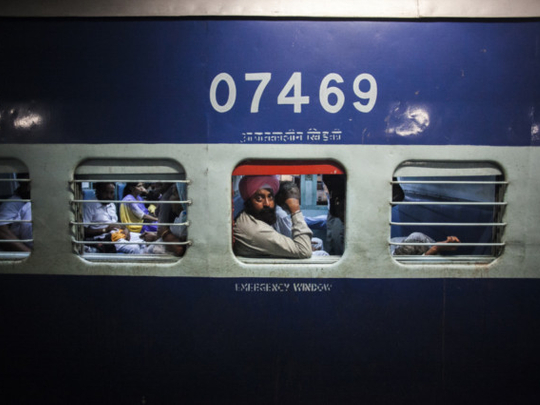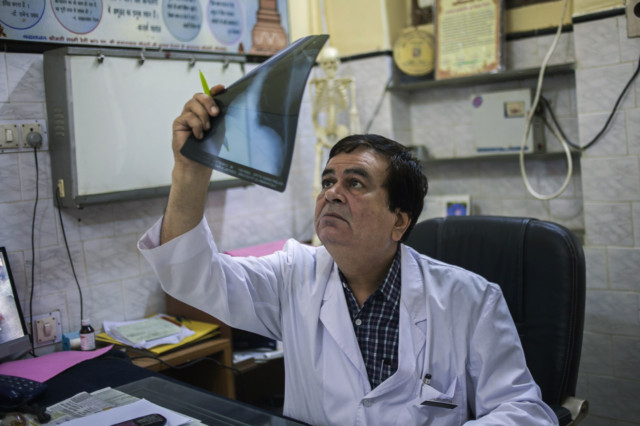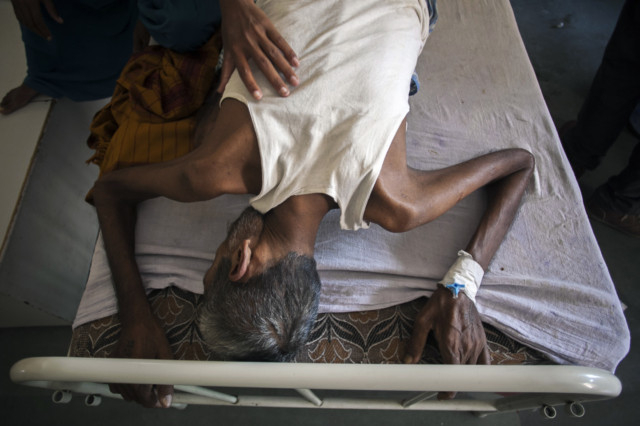
Mahendra Singh parts the crowd massed on the dimly lit platform to pull his ailing mother-in-law on board the train, locals call, the Cancer Express.
The farmer from northern India jostles for space in the blue train before gently laying Charanjit Kaur down on the bare wooden bench. Cradling two small bags, the couple are bound on the overnight train for a hospital a state away in Rajasthan, where she has to be tested for suspected water poisoning.
“I thought we were done with this disease,” said Mahendra, 55, who lost his mother to breast cancer four years ago. “But it never goes away. People say we’ve dirtied our water and that’s why we’re suffering.”
Mahendra and other farmers across Punjab state have helped India double farm yields in 50 years, making the country a food exporter from a chronically hungry one in the 1960s. The “Green Revolution” introduced them to chemical fertilisers and pesticides that seeped into increasingly scarce water sources, and contaminated food and soil. People in the second most populous nation are now paying for it with their lives.
With health issues costing India 2 per cent of its gross domestic product (GDP) a year at a time the economy is growing at its slowest pace in a decade, Mahendra paid less than $2 (Dh7) in rupees for the 330-kilometre trip.
About 50 others aboard the train are also bound from Bhatinda to Bikaner, to the same hospital, for the same tests to see whether the water in their area is contaminated or toxic. Some are so sick that they might not return.
Mahendra and his mother-in-law eat Indian bread and pickle for dinner, which they fetch from a cloth bag.
Pesticide, overused on wheat fields critical to feeding Indians, that ended up in drinking supplies or arsenic in water drained by wells may have led to the lung cancer that convulses the septuagenarian, leaving her gasping for air.
Their railway car has windows with iron rods and shutters. There is no air conditioning anywhere. A ticket checker walks past Mahendra and Charanjit.
“The train has always been meant for the cancer patients, this is the reason this train exists,” said the checker, Munna Lal, in black trousers, jacket and a white shirt, sweat beading his forehead on a humid night.
In a country where one in five rural households have no drinking water, sanitation or electricity, Punjab is India’s most irrigated state. It was among the first to embrace Nobel Peace Prize-winning agronomist Norman Borlaug’s “Green Revolution” that pumped up crop production.
Four decades later, wheat yields have more than doubled to two tonnes a hectare.
Yet chemicals, such as arsenic and fluoride, some that found their way into water, others naturally occurring in less potent amounts that grew more concentrated as wells and aquifers were drained, began causing clusters of diseases and health issues in India, according to the World Bank.
Deaths related to contaminated and dirty water aren’t restricted to India. Dysentery from unclean water at an orphanage in the Democratic Republic of Congo left 31 children dead, according to the Christian adoption agency All Blessings International.
Cancer rates in the Santa Fe province of Argentina, the third biggest soybean producer, are at least double the national average as pesticide applications settled on water sources and villagers stored water in pesticide containers, the Associated Press reported on October 21.
Heavily polluted underground water has caused more than 200 “cancer villages”, with rates far above the national average, to crop up in China, Wang Hao, a water specialist with the Chinese Academy of Engineering, was cited as saying by Caijing magazine on September 17.
Dirty water and inadequate sanitation cause 10 per cent of all deaths in India, Asia’s third biggest economy. Severe surface and groundwater contamination has affected 65 million people across India, a report on the government website shows.
About 200,000 children, 4 years old and younger, die across India annually because of diarrhoeal diseases, according to a study in the Lancet medical journal. Waterborne diseases affect almost 38 million Indians annually, the WaterAid group said.
Over the past five years, more than 34,000 people died of cancer in Punjab alone, the government said.
“Poison has got into our water and our food,” Chander Parkash, assistant professor at Punjab Technical University, said. His study of contamination and depletion of groundwater tables and soil revealed a link with cancer deaths in the state’s Malwa region. “We’ve used so much chemicals that our rivers and aquifers are now spreading death,” he said.
The government has tried to make more people aware of the dangers of pesticides, with farmers told to use only safe chemicals as recommended on product labels, Agriculture Commissioner J.S. Sandhu said.
Jarnail Singh, 72, a retired teacher in Punjab’s Jajjal village, noticed cancer numbers growing in 1998. Back then, his village of 3,500 had ten cancer cases. In four years it doubled. About 55 villagers have died from cancer in Jajjal in the past 15 years, Singh said.
He has sowed cotton and planted vegetables in his 5-acre field for years, spraying pesticides to try to get 20 kilograms of cotton from each acre. Without the fertilisers and pesticides, he said his yield is 4 kilograms an acre.
“We’re stuck,” said Jarnail, sitting on a bed in a bare white-washed room by his 80-year-old brother at their ancestral home. “This is slow poison but we can’t get out of it.”
Back in the 1970s when Jarnail was younger, then prime minister Indira Gandhi charged geneticist Monkombu Sambasivan Swaminathan with developing high-yield crops to help reduce imports in India, whose government runs the world’s biggest food programme for the poor.
In the past century, India endured three droughts and two famines including the one in Bengal in 1943 in pre-Partition British India that killed at least 1.5 million. Swaminathan brought wheat seeds developed in Mexico by Borlaug to India and cross-bred them with local species to produce a higher-yielding variety.
The hybrid seeds, coupled with higher use of fertilisers, helped India raise foodgrain production from 82 million tonnes in 1960 to 250 million tonnes in the fiscal year ended March 2012.
Though they increase the harvests, chemical compounds in fertilisers and pesticides contaminate agricultural run-off that pollutes adjacent waterways such as canals and seeps into the groundwater, said David Michel, Washington-based director for environmental security at the Stimson Center.
About 55 cubic kilometres of waste water gets dumped in the Indus River every year, with 90 percent of the effluents from agriculture, according to the United Nations Environmental Programme website.
In the first nine months of 2013, the United States returned 1,613 export items to India. A basmati rice cargo exported from Amritsar in Punjab on September 16 was rejected by the US due to the presence of pesticide chemicals, according to the website.
Fertiliser use in India has climbed to 26.5 million tonnes in the year ended March 2010, compared with 6.1 million tonnes in 1981-1982, government figures show.
The nation’s imports of chemicals jumped to as high as 9.1 million tonnes in 2009-2010 from 2 million tonnes in 1980-1981, as the population climbed to 1.2 billion in 2012, second only to China, from 454 million in 1961.
Most fertilisers and chemicals are used by farmers without monitoring or guidance and many of them can’t read, said Ajay Jakhar, chairman of the farm group Bharat Krishak Samaj. Illiterate farmers frequently rely on traders for word on how to use the chemicals. Seven in ten Indians live in rural and semi-urban areas where literacy rates are as low as 46 per cent.
“We always ask farmers not to spray the pesticides before the outbreak of any disease or pest-attack,” said Sandhu, the agriculture commissioner. “If they apply before, they take the risk. Farmers should use those chemicals which are safe; they should be made aware that the produce should not have chemical residues, otherwise it will not fetch returns.”
The equipment that farmers use to spray pesticides often is washed in canals and rivers. The same contaminated water that flows through these canals is then stored in village tanks for drinking, Jakhar said.
“Farmers aren’t being counselled on how much fertiliser and pesticides are needed to grow a crop, and this has led to abuse,” he said. “India became complacent in advising farmers after achieving the ‘Green Revolution’ goals. Governance has obviously failed.”
India’s Department of Chemicals and Petrochemicals isn’t mandated to educate farmers about pesticide use, Director Sanjay Bansal said. It is the role of the Ministry of Agriculture to reach out to growers on use of chemicals, he said.
Water and soil contamination are high in Tamil Nadu, Maharashtra and the northeastern states, in addition to Punjab, said Bharat Sharma, New Delhi-based principal researcher at the International Water Management Institute.
“The full onslaught of the Green Revolution and fertiliser was first unleashed in Punjab and it’s now coming back to hurt them the most,” said Om Rupela, adviser to the UN Food and Agriculture Organisation and a former scientist with the International Crops Research Institute.
“Some pesticide residues remain in the soil and food for as many as 30 years and these show up as diseases many years later,” said Rupela, based in the southern city of Hyderabad.
Back at Jarnail’s home, cancer is a way of life. He has cremated three relatives in four years. When he has guests, Jarnail assures them his water is purified and safe to drink.
That is in part because both he and his elder brother have had to take the Cancer Express that starts north of Bhatinda in Abohar.
A year ago, India’s Central Ground Water Board started studying Punjab’s water quality and whether pesticide and fertiliser pollution is killing people, Chairman Sushil Gupta said. The study will take another year to complete.
“It is possible that people are falling ill because they spray pesticides without protective gear,” Gupta said. “I wouldn’t like to say more because we’re still studying it.”
In the hospital at Bikaner, Mahendra is paying 30 rupees (Dh1.76) a day for a bed and Rs5 for a meal for the care of his mother-in-law.
That the hospital offers free medicine, and doctor visits, makes it worth travelling twice as far as to a hospital in Faridkot that started a cancer ward in 2009.
Almost 70 per cent of the cancer patients the hospital treats are from Punjab and Haryana, states that supply more than a third of India’s wheat.
Bikaner treated about 7,000 cancer patients in 2012, 1,100 more than the previous year, said Ajay Sharma, head of the radiotherapy department at the Acharya Tulsi Regional Cancer Treatment & Research Institute. He expects 8,000 to visit this year.
Cancer replaced heart disease as the world’s leading cause of death in 2010. For India, still struggling with tuberculosis and hunger among its poorest, it challenges an already overburdened medical system.
India has spent Rs1.56 trillion on water supply and sanitation projects in the past 60 years. Still, infrastructure has struggled to keep pace with demands of industry and a growing population.
“Add to this mix the problem of water quality and it looks very scary,” said Chandra Bhushan, deputy director at the Delhi-based Centre for Science and Environment.
Almost 90 per cent of chemicals used in farms to boost yields end up in water sources in India, Bhushan said. “We focused so much on growing food that we may not have enough clean water for future generations.”
At the hospital, Mahendra and Charanjit don’t know why cancer is killing villagers. Fly ash from two old power stations in Bhatinda and a refinery increased the arsenic content in the soil, locals say. Sitting on the train that stops at 27 stations during an eight-hour journey, Mahendra holds out little hope for his mother-in-law.
“She understands she’ll probably die but I don’t think she’s afraid,” he said. “Are people dying in other parts of India or is God angry only with us?”
–Washington Post
Sidebar: A crisis looming
“Providing safe drinking water, maintaining aquifers and keeping the water flowing is the biggest challenge for India,” said Rajendra Singh, winner of the Ramon Magsaysay award for bringing water to parched areas of Rajasthan. “Water is quickly becoming India’s biggest crisis and threatening economic growth.”
More than a fifth of India’s land area and 17 per cent of its people may face “absolute water scarcity” by 2050 as farmers, cities and industries compete for the resource and climate change affects its geography and weather patterns, according to a Ministry of Agriculture report.
Per-capita availability of water, about 1,704 cubic metres in 2010, is projected to drop to 1,235 cubic metres by 2050, the report said.
In 2000, almost all of India’s major rivers had already exceeded their nitrogen-absorbing capacity — nitrogen is the principal component of many man-made fertilisers, Michel said.
The OECD projects that by 2030, nitrogen effluents in India’s wastewater will quadruple from 2000 levels to almost 2 million tonnes annually, as phosphorus surges almost fourfold.





